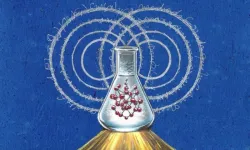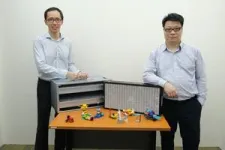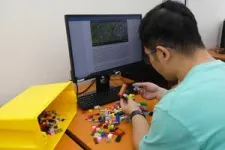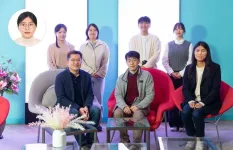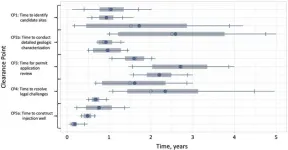(Press-News.org) In quantum mechanics, particles can exist in multiple states at the same time, defying the logic of everyday experiences. This property, known as quantum superposition, is the basis for emerging quantum technologies that promise to transform computing, communication, and sensing. But quantum superpositions face a significant challenge: quantum decoherence. During this process, the delicate superposition of quantum states breaks down when interacting with its surrounding environment.
To unlock the power of chemistry to build complex molecular architectures for practical quantum applications, scientists need to understand and control quantum decoherence so that they can design molecules with specific quantum coherence properties. Doing so requires knowing how to rationally modify a molecule’s chemical structure to modulate or mitigate quantum decoherence. To that end, scientists need to know the “spectral density,” the quantity which summarizes how fast the environment moves and how strongly it interacts with the quantum system.
Until now, quantifying this spectral density in a way that it accurately reflects the intricacies of molecules has remained elusive to theory and experimentation. But a team of scientists has developed a method to extract the spectral density for molecules in solvent using simple resonance Raman experiments—a method that captures the full complexity of chemical environments. Led by Ignacio Franco, an associate professor of chemistry and of physics at the University of Rochester, the team published their findings in the Proceedings of the National Academy of Sciences.
Using the extracted spectral density, it is possible not only to understand how fast the decoherence happens but also to determine which part of the chemical environment is mostly responsible for it. As a result, scientists can now map decoherence pathways to connect molecular structure with quantum decoherence.
“Chemistry builds up from the idea that molecular structure determines the chemical and physical properties of matter. This principle guides the modern design of molecules for medicine, agriculture, and energy applications. Using this strategy, we can finally start to develop chemical design principles for emerging quantum technologies,” says Ignacio Gustin, a chemistry graduate student at Rochester and the first author of the study.
The breakthrough came when the team recognized that resonance Raman experiments yielded all the information needed to study decoherence with full chemical complexity. Such experiments are routinely used to investigate photophysics and photochemistry, but their utility for quantum decoherence had not been appreciated. The key insights emerged from discussions with David McCamant, an associate professor in the chemistry department at Rochester and an expert in Raman spectroscopy, and with Chang Woo Kim, now on the faculty at Chonnam National University in Korea and an expert in quantum decoherence, while he was a postdoctoral researcher at Rochester.
The team used their method to show, for the first time, how electronic superpositions in thymine, one of the building blocks of DNA, unravel in just 30 femtoseconds (one femtosecond is one millionth of one billionth of a second) following its absorption of UV light. They found that a few vibrations in the molecule dominate the initial steps in the decoherence process, while solvent dominates the later stages. In addition, they discovered that chemical modifications to thymine can significantly alter the decoherence rate, with hydrogen-bond interactions near the thymine ring leading to more rapid decoherence.
Ultimately, the team’s research opens the way toward understanding the chemical principles that govern quantum decoherence. “We are excited to use this strategy to finally understand quantum decoherence in molecules with full chemical complexity and use it to develop molecules with robust coherence properties,” says Franco.
END
New strategy reveals ‘full chemical complexity’ of quantum decoherence
The findings can be used to design molecules with custom quantum coherence properties, laying the chemical foundation for emerging quantum technologies.
2023-12-19
ELSE PRESS RELEASES FROM THIS DATE:
Barbie should expand her range of medical and scientific professions
2023-12-19
Barbie should consider expanding her medical and scientific careers into areas where women and other under-represented groups remain a minority, suggests a study published in the Christmas issue of The BMJ.
The ever-popular fashion doll has been everything from a construction worker, teacher, and veterinarian to a judge, scientist, and medical doctor, symbolising careers that children can aspire to one day hold.
But no previous studies have analysed Barbie medical professional and scientist ...
Doctor Who festive specials linked to lower death rates
2023-12-19
A new Doctor Who episode shown during the festive period, especially on Christmas Day, is associated with lower death rates in the subsequent year across the UK, finds a study published in the Christmas issue of The BMJ.
The findings highlight the positive effect doctors can have when working during the festive period and may prompt the BBC and Disney+ to broadcast new episodes of Doctor Who every festive period, ideally on Christmas Day, says the author.
Sixty years ago, the ...
Hospital coffee machines get a clean bill of health
2023-12-19
Healthcare workers will be relieved to know that hospital coffee machines are not responsible for spreading disease and a general ban doesn’t seem necessary, finds a study published in the Christmas issue of The BMJ.
In a bid to eliminate hospital acquired (nosocomial) infections, various objects have been investigated as breeding grounds for bacteria including doctors’ ties and even hospital Bibles.
But despite being regularly touched by lots of bare hands, the potential of hospital coffee machines as a source of infection had not previously been explored.
To address this, researchers in Germany assessed the microbial population in healthcare associated coffee machines, ...
Common drug for cardiac failure jams a debated blood test for Alzheimer’s disease
2023-12-19
Alzheimer’s disease (AD) is associated with damaging protein aggregates in the brain, with β-amyloid (Aβ) aggregates called plaques being the key pathology. Entresto (sacubitril/valsartan) is a combined neprilysin inhibitor and angiotensin receptor blocker, approved for the treatment of heart failure. Concerns were raised by the FDA that this neprilysin inhibition treatment may increase the risk of AD, since neprilysin is one of the main enzymes responsible for degrading Aβ in the brain. The PERSPECTIVE trial (NCT02884206) showed that 3-year neprilysin inhibition treatment was not associated ...
Disadvantaged children’s struggles at school have “little to do” with character, attitude or a lack of ‘growth mindset’
2023-12-19
The relative underperformance of disadvantaged students at school has little do with them lacking the ‘character’, attitude, or mindset of their wealthier peers, despite widespread claims to the contrary, new research indicates.
The study, which analysed data from more than 240,000 15-year-olds across 74 countries, challenges the view often invoked by politicians and educators that cultivating self-belief or ‘growth mindsets’ can reduce class-based learning gaps. Researchers found that no more than 9% of the substantial achievement gap between ...
Unveiling molecular origami: A breakthrough in dynamic materials
2023-12-19
Origami, traditionally associated with paper folding, has transcended its craft origins to influence a diverse range of fields, including art, science, engineering, and architecture. Recently, origami principles have extended to technology, with applications spanning solar cells to biomedical devices. While origami-inspired materials have been explored at various scales, the challenge of creating molecular materials based on origami tessellations has remained. Addressing this challenge, a team of researchers, led by Professor Wonyoung Choe in the ...
Scientists spread festive cheer as research reveals Christmas dinner can be healthy
2023-12-19
In less than a week’s time, families around the country will be sitting down to tuck into their traditional Christmas dinner.
While the festive season is often a time of overindulgence, could parts of a festive banquet actually help improve our health?
Experts at Newcastle University, UK, have been researching the different characteristics and compounds of festive trimmings and have found that some of the side-dishes offer significant benefits.
Fighting chronic conditions
Soggy sprouts should be off the menu say Newcastle researchers – ...
U.S. utilities on track to be 100% renewable by 2060
2023-12-18
Utilities in the United States have pledged to transition to 100% renewable electricity by 2060, and although state mandates have played a role, it’s the utilities, themselves, that are leading the transition.
“Many people feel the transition on the policy side isn’t going fast enough,” said Matthew Burgess, a CIRES fellow, CU Boulder assistant professor, and co-author of the paper published today in Climatic Change. “But the private sector is moving faster than we thought. A lot has ...
Giant bacterium uses unique processes to power itself
2023-12-18
Not all bacteria are created equal.
Most are single-celled and tiny, a few ten-thousandths of a centimeter long. But bacteria of the Epulopiscium family are large enough to be seen with the naked eye and 1 million times the volume of their better-known cousins, E. coli.
In a study published Dec. 18 in Proceedings of the National Academy of Sciences, researchers from Cornell and Lawrence Berkeley National Laboratory have for the first time described the full genome of one species of the family of giants, which they’ve named Epulopiscium viviparus.
“This incredible giant bacterium is unique and interesting ...
Quantifying barriers to establishing sequestration wells
2023-12-18
Carbon capture and sequestration (CCS), the process of capturing and storing atmospheric carbon dioxide, is one method of reducing the amount of carbon dioxide in the atmosphere in efforts to reduce the impacts of climate change. While CCS is an essential tool in decarbonizing the U.S. economy, there are barriers that exist to the development, approval, and implementation of a geologic sequestration site, as it requires an appropriate geologic formation, as well as an approved injection facility.
Recent work from the Carnegie Mellon University Department of Engineering and Public Policy (EPP) estimates the time required to develop, approve, and implement ...
LAST 30 PRESS RELEASES:
Heart-brain connection: international study reveals the role of the vagus nerve in keeping the heart young
Researchers identify Rb1 as a predictive biomarker for a new therapeutic strategy in some breast cancers
Survey reveals ethical gaps slowing AI adoption in pediatric surgery
Stimulant ADHD medications work differently than thought
AI overestimates how smart people are, according to HSE economists
HSE researchers create genome-wide map of quadruplexes
Scientists boost cell "powerhouses" to burn more calories
Automatic label checking: The missing step in making reliable medical AI
Low daily alcohol intake linked to 50% heightened mouth cancer risk in India
American Meteorological Society announces Rick Spinrad as 2026 President-Elect
Biomass-based carbon capture spotlighted in newly released global climate webinar recording
Illuminating invisible nano pollutants: advanced bioimaging tracks the full journey of emerging nanoscale contaminants in living systems
How does age affect recovery from spinal cord injury?
Novel AI tool offers prognosis for patients with head and neck cancer
Fathers’ microplastic exposure tied to their children’s metabolic problems
Research validates laboratory model for studying high-grade serous ovarian cancer
SIR 2026 delivers transformative breakthroughs in minimally invasive medicine to improve patient care
Stem Cell Reports most downloaded papers of 2025 highlight the breadth and impact of stem cell research
Oxford-led study estimates NHS spends around 3% of its primary and secondary care budget on the health impacts of heat and cold in England
A researcher’s long quest leads to a smart composite breakthrough
Urban wild bees act as “microbial sensors” of city health.
New study finds where you live affects recovery after a hip fracture
Forecasting the impact of fully automated vehicle adoption on US road traffic injuries
Alcohol-related hospitalizations from 2016 to 2022
Semaglutide and hospitalizations in patients with obesity and established cardiovascular disease
Researchers ‘listen in’ to embryo-mother interactions during implantation using a culture system replicating the womb lining
How changing your diet could help save the world
How to make AI truly scalable and reliable for real-time traffic assignment?
Beyond fragmented markets: A new framework for efficient and stable ride-pooling
Can shape priors make road perception more reliable for autonomous driving?
[Press-News.org] New strategy reveals ‘full chemical complexity’ of quantum decoherenceThe findings can be used to design molecules with custom quantum coherence properties, laying the chemical foundation for emerging quantum technologies.
